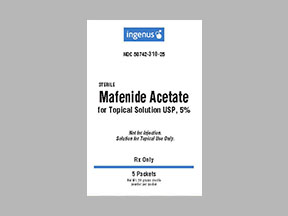
Mafenide Acetate Coupons & Savings Card – Discount Prices from $120.09
Generic for: Sulfamylon
This medication is used alone or with other medications to help prevent and treat wound infections in patients with severe burns. Mafenide is a drug applied to the skin that belongs to a class of drugs known as sulfa antibiotics. It works by killing bacteria that may infect an open wound. Killing bacteria helps to promote wound healing and to decrease the risk of the bacteria spreading to surrounding skin or to the blood, thereby helping to prevent a serious blood infection (sepsis).
Our coupons are free to use. Before paying, show the pharmacist your Mafenide Acetate savings card to get your free discount. Use our filters below to edit the prescription box to match your needs. The Mafenide Acetate prices will update based on your prescription needs. Above our Mafenide Acetate coupons, you can change your location to see pharmacy prices and costs in other areas. We're here to help you buy Mafenide Acetate at the lowest price with our prescription discount card.
My prescription
Edit
5%, Mafenide Acetate (1 Packet)
Select pharmacy

CVS
$140.32
COUPON PRICE
Walmart
$120.09
COUPON PRICE
Walgreens
$131.08
COUPON PRICE
Albertsons
$684.81
COUPON PRICEMafenide Acetate savings card
Show this card to your pharmacist
Walmart
$120.09
BIN
ID
PCN
GRP
019876
LH1CCFAD1A
CHIPPO
LHX
Powered by
This medication is used alone or with other medications to help prevent and treat wound infections in patients with severe burns. Mafenide is a drug applied to the skin that belongs to a class of drugs known as sulfa antibiotics. It works by killing bacteria that may infect an open wound. Killing bacteria helps to promote wound healing and to decrease the risk of the bacteria spreading to surrounding skin or to the blood, thereby helping to prevent a serious blood infection (sepsis).
Our coupons are free to use. Before paying, show the pharmacist your Mafenide Acetate savings card to get your free discount. Use our filters below to edit the prescription box to match your needs. The Mafenide Acetate prices will update based on your prescription needs. Above our Mafenide Acetate coupons, you can change your location to see pharmacy prices and costs in other areas. We're here to help you buy Mafenide Acetate at the lowest price with our prescription discount card.
Our coupons are free to use. Before paying, show the pharmacist your Mafenide Acetate savings card to get your free discount. Use our filters below to edit the prescription box to match your needs. The Mafenide Acetate prices will update based on your prescription needs. Above our Mafenide Acetate coupons, you can change your location to see pharmacy prices and costs in other areas. We're here to help you buy Mafenide Acetate at the lowest price with our prescription discount card.
